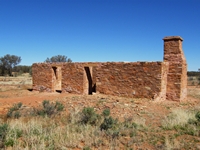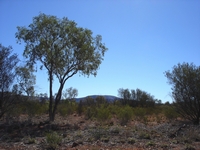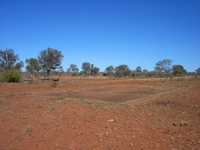Australia So Much to See



Alice Springs to Tennant Creek - A journey through the centre of Australia
Leaving Alice Springs we head north on the Stuart Highway on the route which will eventually take us to Darwin, with so much to see
along the way over the next five weeks.
One kilometre past the Tanami turnoff, we reached a marker showing the highest
point on the
Once again we crossed the Tropic of Capricorn, leaving the southern latitudes behind for another two months.
There are numerous plaques, markers and monuments along the Highway. One is this memorial to explorer Peter Egerton-Warburton.
The Aboriginal name means ‘back of the shoulder’ and refers to the shape of the Range.
Native Gap Conservation Area surrounds
a section of the
The
Ned and his brother Jeremiah (Jerry) dug this 23 metre well by hand, in addition to a number of other wells. Water was drawn by a windlass to fill the stock trough and some of the posts still remain. Later a tank was added and the bricks from where it stood can be seen. A stone structure was paced around the well with a wooden head frame to assist water drawing. Only the stone structure remains. A plaque details the complex process of water drawing by horse drawn whip.
In 1914 the Nicker family settled at Ryan’s Well after their dray collapsed on the route north. They built a home of mulga and clay,
naming it Glen Maggie after their youngest child Margaret. Sam Nicker and his family established a sheep and cattle station here. Ryan Well was their main water supply. This homestead was built in 1918 to replace the family’s original mulga wood and mud
dwelling.
From 1921, the homestead also served as a small store and telegraph office for the growing population of the
areas. The family sold Glen Maggie Station to neighbouring station owner Norrie Claxton in 1929 and it became part of Aileron
Station. However this building continued to operate as a store and telegraph office. In 1932 it was well known as the
last supply point for hopeful miners heading
The stone ruins remaining once constituted the bedroom and
sitting room. The additional rooms including kitchen, dining room, bathroom and store were probably later additions of a less
durable building material and are long gone.
Seventy kilometres north of the Ryans Well Historical Reserve is the roadhouse
and small community of Aileron, with large metal statues, the most obvious being of a man with a spear placed on a hill.
This line opened up the previously little known interior, and as a result of transport through the regions, gold was discovered in
locations such as the Tennant Creek area, and new pastoral grazing areas were discovered.
The Central Mount Stuart Historical Reserve commemorates the discovery of Central Mount Stuart, which was calculated to be mid way
between
The 3178 kilometre line was built in less than two years and joined on 22 August 1872. It linked
In an inhospitable climate and environment and sometimes meeting hostile natives, travelling through this unknown land was not without
incident. As a testament to the harsh conditions, we passed a Memorial to C. Palmer; a teamster who died along the way.
Barrow Creek, nestled in scenic hills, was the site of one of fifteen a repeater stations for the Overland Telegraph Line. The
Telegraph Station can be visited at the north side of the tiny town, which now has little more than a roadhouse. Lack of water
limited any growth of the town.
During World War II Barrow Creek was used by the Australian Army as a staging camp for
convoys of troops and supplies, which was known as No. 5 Australian Personnel Staging Camp. It was the first overnight stop on the
northern trip from
The historic site is now part of Neutral Junction Station, but can be visited by responsible travellers. The site is approximately
one kilometre east of the
New Barrow Staging Camp from signage at the site
Warburton had already made many exploratory expeditions, and the
Peter Egerton-Warburton
Left the known here for the unknown
On April 18th 1873
With his son Richard, J.W. Lewis, Dennis White, Charley,
Sahleh and Halleem,
After suffering many privations, hunger and thirst crossing the
Erected by his relatives
To commemorate the 100th Anniversary of his death November 5th 1889
A giant carpet snake ancestor came out of the small waterhole near this Gap. Before leaving the soak he sang a song which was
so full of emotion that it brought a lump in the throat of the young maidens. The snake travelled
Buried in this vicinity
C. Palmer - Teamster
Died August 1871
Whilst serving with a survey party during the construction of the Overland
Telegraph Line.
John McDouall Stuart and William Kekwick ascended and named
This staging post was the first overnight stop for troops moving north from
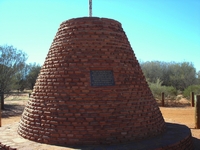
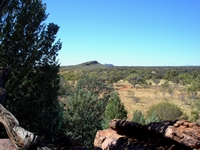
Connors Well was used to supply water which was carted to Glen Maggie Station. While there is no evidence remaining of the original
well, a dam with tank and trough now supplies water to the station cattle.
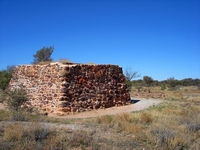
Glen Maggie Station
The Overland Telegraph Line, linking
